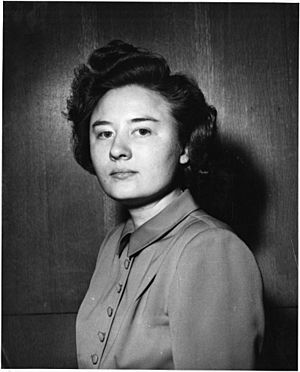Mildred Rebstock facts for kids
Quick facts for kids
Mildred Catherine Rebstock
|
|
|---|---|
 |
|
| Born | November 29, 1919 |
| Died | February 17, 2011 (aged 91) Ann Arbor
|
| Nationality | American |
| Alma mater | North Central College, University of Illinois at Urbana-Champaign |
| Known for | Synthesizing chloromycetin |
| Awards | Women's National Press Club of Washington DC "Science Woman of the Year" (1950) |
| Scientific career | |
| Fields | Chemistry |
Mildred Catherine Rebstock (born November 29, 1919 – died February 17, 2011) was an American scientist who worked with medicines. She was a pharmaceutical chemist. Mildred and her team were the first to completely create a medicine called chloromycetin in a lab. This medicine is also known as chloramphenicol. This was a very important moment because it was the first time an antibiotic was fully made by humans. The World Health Organization says this medicine is very important for human health.
Contents
Early Life and Education
Mildred Catherine Rebstock was born on November 29, 1919, in Elkhart, Indiana. Her parents were Redna and Adolph Rebstock. She finished Elkhart High School in 1938. After high school, she went to North Central College.
While at North Central College, Mildred was a top student. She was part of a biology honors group called Beta Beta Beta. She also joined the college's zoology club. Mildred earned perfect grades while studying with her chemistry and zoology professors. These professors inspired her to continue her studies.
After getting her bachelor's degree in 1942, Mildred decided to go to the University of Illinois at Urbana-Champaign. She received a special scholarship to study there. She earned her master's degree in 1943. Then, she completed her doctorate degree in 1945.
Professional Career and Discoveries
Dr. Rebstock started working at Parke-Davis Research Labs in 1945. She began as a junior research chemist. Later, in 1959, she became a research leader. She worked there until 1977.
Work with Streptomycin
Around the time she became a research leader, Dr. Rebstock and her team were studying a new antibiotic. This antibiotic was called streptomycin. It was first found by a scientist named Albert Schatz.
Dr. Rebstock's team, which included John Controulis, Harry Crooks, and Quentin Bartz, made an important discovery. They found a way to make streptomycin more stable. They used a process called catalytic hydrogenation. This new, more stable medicine was named dihydrostreptomycin. Another team at Merck & Co. made the same discovery at the same time. Today, dihydrostreptomycin is not used for humans. However, it is still used in veterinary medicine to treat animals.
Synthesizing Chloromycetin
Soon after her work with dihydrostreptomycin, Dr. Rebstock received a new task. She needed to create a new antibiotic in the lab. This antibiotic was found by John Ehrlich. It came from a type of bacteria called Streptomyces venezuela.
The new antibiotic's structure was simpler than other antibiotics. This made Dr. Rebstock's job a bit easier. Scientists found that a key part of this medicine was a special chemical ring. Dr. Rebstock's lab already had experience with this type of chemical.
Around November 1947, Dr. Rebstock found a way to completely create this antibiotic in the lab. This was a big deal! Usually, it was cheaper to grow antibiotics using natural processes. But for this medicine, it was cheaper to make it in the lab. Her team shared their discovery in 1949.
Because Dr. Rebstock made it easier to produce chloromycetin, it became widely available. It was used to treat serious illnesses like Typhoid fever and Rocky Mountain fever. Even today, it is used as a backup medicine for very serious cases. These include some types of meningitis and cholera.
Over time, doctors learned that chloromycetin could sometimes cause a rare but serious blood problem. Because of this, its use in humans has gone down in countries like the United States. However, it is still a very important antibiotic in many developing countries. It is on the World Health Organization's List of Essential Medicines. This list includes the most important medicines needed in a basic health system.
Awards and Legacy
Dr. Rebstock's amazing research gained a lot of attention. In 1949, Time Magazine wrote an article about her. They said that her achievement was a team effort. But they also noted that "a large part of the credit goes to pretty Dr. Mildred Rebstock, a 28-year-old research chemist."
Dr. Rebstock cared about women working in science. In an interview, she said that only about three percent of researchers in her field were women. But she was hopeful that more women would join science in the future. In 1950, she received the "Science Woman of the Year" award. The Women's National Press Club of Washington DC gave her this award. President Truman presented it to her.
Mildred Rebstock continued her research on medicines for the rest of her career. Later, she studied medicines for fertility and those that help control blood fats. She passed away on February 17, 2011, in Ann Arbor, Michigan.
Images for kids
See also
 In Spanish: Mildred Rebstock para niños
In Spanish: Mildred Rebstock para niños


